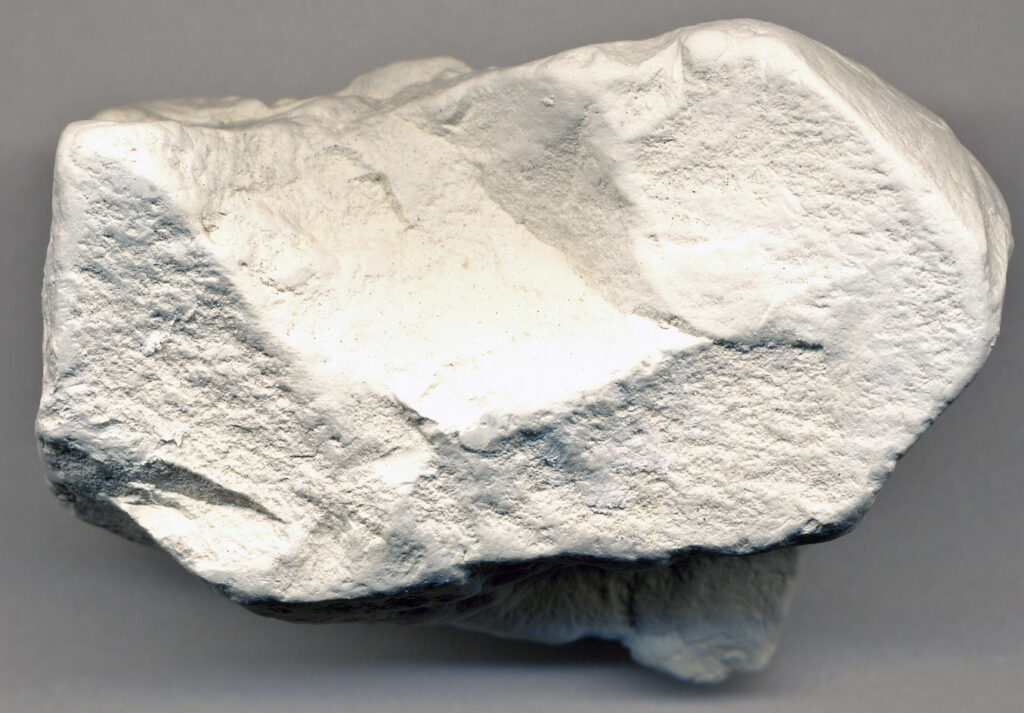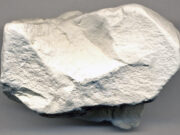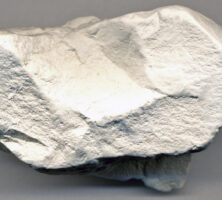Kaolin is one of Georgia’s largest natural resources. According to the U.S. Geological Survey, more than 8 million metric tons of kaolin are mined from Georgia each year, with an estimated value of more than $1 billion. Georgia is by far the leading clay-producing state in America and is recognized as a world leader in the mining, production, processing, and application of kaolin products.
The word kaolin is derived from the name of the Chinese town Kao-Ling (or Gaoling, “high ridge”), located in the Jiangxi Province of southeast China, where the written description of porcelain can be found. The word kaolin is now used as a loose trade and geologic term to refer to white clayey rock that is predominantly composed of Kaolin Group (khandite) minerals. The most common constituent is the mineral kaolinite. Kaolinite is a layered silocate made of alternating sheets of octahedrally coordinated aluminum and tetrahedrally coordinated silicon that are bonded by hydroxyl groups. Kaolinite is represented by the chemical formula Al2Si2O5(OH)4, and it most often occurs as clay-sized, platelike, hexagonally shaped crystals.
Georgia kaolin deposits occur in Late Cretaceous (about 100 million to 65 million years ago) to Early Paleogene (65 million to 45 million years ago) sedimentary rocks whose sediments were derived from weathered igneous and metamorphic rocks of the Georgia Piedmont geologic province. During these ancient times, sediments were transported by rivers to coastline deltas and to estuarine and back-barrier island locations. Relative sea-level changes provided environments of deposition favorable for the accumulation of the lens-shaped geometry of the present-day deposits. Since then further mineralogical changes have occurred to the sediments. The varied and complex geologic history that different kaolin deposits have experienced results in an array of formation properties.

Image from James St. John
Kaolin in Georgia is generally found in a northeast to southwest band of deposits extending from Augusta to Macon to Columbus. This belt parallels the fall line, which marks the boundary between the Piedmont and the Coastal Plain. Deposits are of three types: (1) “soft” kaolin, which breaks easily and is soapy in texture; (2) “hard” kaolin, which is more finely grained, difficult to break, and jagged in texture; and (3) “flint” kaolin, which has no commercial value because its high opaline silica content makes it extremely hard. Kaolin mining activities are restricted to near-surface (less than 150 meters) ore bodies that are 3 to 15 meters thick. Once the ore has been extracted, mine reclamation activities are conducted to restore the landscape to a pristine state.
Kaolin is most commonly used in the paper-coating industry. It is also used as a filler (added to plastics, for example, and rubber compounds), as a pigment additive in paints, in ceramics (tile, chinaware, and bathroom toilets and sinks), and in pharmaceuticals. Depending upon the application, kaolins are typically processed to remove such naturally coexisting materials as quartz, iron oxides, titanium oxides, other clay minerals, and organic matter. Kaolin is often further modified from its natural state by chemical treatments, physical delaminating, and high temperature heating to more than 1,000 degrees centigrade. These latter modifications are designed to enhance chemical bonding properties of the kaolin when mixed with other components and/or to improve the brightness of kaolin-based products.
Kaolin is mined and processed in many countries worldwide. Evaluation of refined kaolin output, however, is a far more meaningful way to estimate the economical state of the industry. The China Clay Producers Association represents the major producers and processors of Georgia kaolin. Members are Engelhard Corporation, Gordon; IMERYS Pigments and Additives Group, Atlanta; J. M. Huber Corporation, Atlanta; and Thiele Kaolin Company, Sandersville. The industry posted an after-tax profit of $33.2 million in 1999, which represents a return of 2.7 percent on its net investment. In 1998 the industry posted a profit of $65.4 million, a return of 5.8 percent. This decline represents rising competition and quality demands. The principal regions of the world that will offer competition to Georgia in the near future include Brazil, China, and Australia.






